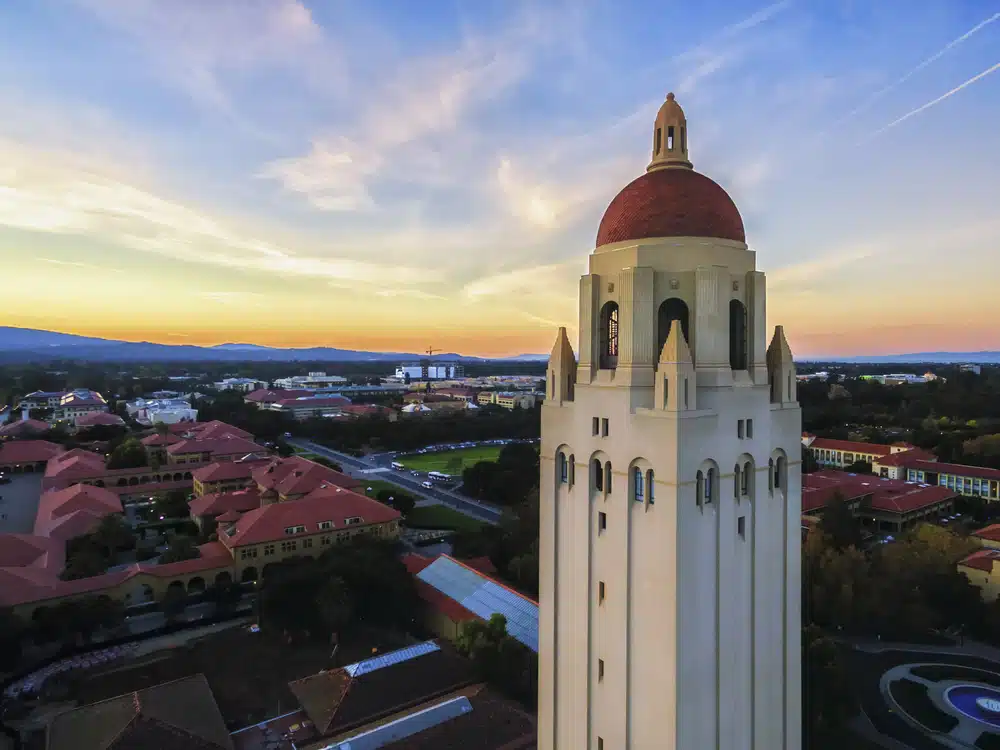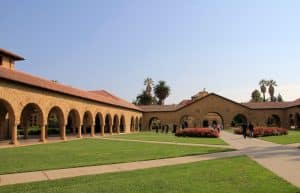Fun Facts About Stanford
Stanford University is more than just an institution; an education hub, a ground for innovation, and a source of immense pride for its students and alums. Stanford is the birthplace of noble ideas and incredible legacies. Read on to discover ten fun facts about this prestigious university.
The Founding of Stanford University
Stanford University, one of the most prestigious educational institutions in the world, has a rich history that dates back to its establishment in 1885. The university was founded by Leland and Jane Stanford, who were driven by a deep desire to honor the memory of their beloved son, Leland Stanford Jr., whose only son had succumbed to typhoid fever at the tender age of 15, leaving his parents devastated.
Leland Stanford Sr., a former governor of California and a prominent railroad tycoon, drew inspiration from the renowned educational institutions on the East Coast. He and his wife, Jane, were determined to create an institution that would serve the West Coast in a similar capacity. Thus, the idea of Stanford University was born.
The Unique Story Behind Stanford’s Establishment
The path to Stanford’s establishment took an unexpected turn. The Stanfords initially planned to expand the University of California, but a falling out with the institution’s president altered their course. Undeterred by this setback, Leland and Jane Stanford decided to forge ahead and establish an independent university embodying their vision.
On a momentous day in 1891, Stanford University opened its doors to 555 eager students, marking the beginning of a new chapter in higher education on the West Coast. The campus, nestled amidst the picturesque landscapes of California, became a beacon of knowledge and innovation.
The Influence of Leland Stanford Jr.
The significance of Leland Stanford Jr. in the university’s founding cannot be overstated. His untimely passing catalyzed his grieving parents to channel their sorrow into a remarkable endeavor: creating a university as a lasting memorial to their beloved son and a testament to their commitment to the children of California.
It is a poignant reminder that Stanford University, with its name forever intertwined with the memory of a young boy, stands as a testament to the power of education and the potential within every young mind.
Stanford’s Iconic Campus
Covering over 8,180 acres, Stanford boasts one of the largest university campuses in the United States. Its iconic design combines evolved architectural styles, presenting a beautiful blend of tradition and innovation.
As you walk through the sprawling campus, you can’t help but be in awe of the architectural wonders surrounding you. The buildings stand tall, each with a unique character and story. From the grandeur of the Stanford Memorial Church to the towering presence of the Hoover Tower, every structure is a testament to the university’s commitment to excellence in design.
The Architectural Marvels of Stanford
The Stanford campus is home to some breathtaking architectural marvels. The Stanford Memorial Church, known for its stunning mosaics, is a place of tranquility and reflection. Its intricate stained glass windows and meticulously crafted stone carvings make it a true masterpiece of Gothic Revival architecture.
Standing at 285 feet, the Hoover Tower is an iconic landmark offering panoramic views of the entire campus and the surrounding Bay Area. Its distinctive design, inspired by the Campanile of St. Mark’s in Venice, adds a touch of elegance to the university’s skyline.
The Cantor Center for Visual Arts is another architectural gem that houses many artworks spanning different periods and styles. Its modernist design seamlessly blends with the surrounding landscape, creating a harmonious environment for art enthusiasts to explore and appreciate.
The Outdoor Art Scene at Stanford
Beyond traditional architecture, Stanford has a robust outdoor art scene that adds another layer of beauty to the campus. As you stroll through the grounds, you’ll come across the Papua New Guinea Sculpture Garden, a hidden gem that showcases a collection of indigenous artworks. These sculptures, with their intricate details and cultural significance, offer a glimpse into the rich heritage of the Pacific region.
Another notable installation is the Stone River sculpture. This massive stone structure winds through the landscape, symbolizing the flow of time and the interconnectedness of nature and human existence. It serves as a thought-provoking reminder of the university’s commitment to exploring the deeper meaning of art and its impact on society.
Stanford’s dedication to the arts extends beyond its campus boundaries. The university actively supports art initiatives in the broader community, fostering creativity and cultural exchange. Through collaborations with local artists and organizations, Stanford enriches the artistic landscape of the surrounding area, creating a vibrant and inclusive arts community.
So, as you explore Stanford’s iconic campus, take the time to appreciate its architectural wonders and the outdoor art scene that adds a touch of creativity and inspiration to every corner. From the grandeur of the buildings to the thought-provoking sculptures, Stanford’s commitment to the arts is evident at every turn.
Stanford’s Academic Excellence
Renowned worldwide for its commitment to academic excellence, Stanford has an enviable reputation for education and research. The university’s dedication to providing a transformative learning experience sets it apart from other institutions. Stanford’s academic programs are designed to challenge and inspire students, encouraging them to think critically and push the boundaries of knowledge.
With a history of over a century, Stanford has consistently been at the forefront of innovation and discovery. Its world-class faculty members are experts in their fields, bringing knowledge and experience to the classroom. Students can learn from these distinguished professors, engaging in thought-provoking discussions and collaborative research projects.
From humanities to engineering, Stanford offers a wide range of academic disciplines, ensuring students can pursue their passions and explore new areas of interest. The university’s research-driven pedagogy fosters intellectual curiosity and empowers students to contribute meaningfully to their chosen fields.
The Pioneering Departments at Stanford
Stanford is home to many pioneering departments, each making significant contributions to their respective fields. The Computer Science Department and the Stanford University School of Medicine are two of the most notable departments.
The Computer Science Department at Stanford is renowned for its groundbreaking research and innovative approach to computer science education. It has played a pivotal role in shaping the Silicon Valley ecosystem, producing some of the world’s most successful entrepreneurs and tech leaders.
The Stanford University School of Medicine is a medical innovation and excellence hub. With a commitment to advancing healthcare through research, education, and patient care, the School of Medicine has made significant breakthroughs in various medical disciplines.
Stanford’s Nobel Laureates
One of the hallmarks of Stanford’s academic excellence is its impressive number of Nobel laureates. As of 2020, the university boasts 83 laureates spread among students, faculty, and staff. These laureates have made groundbreaking contributions to fields as diverse as Physics, Chemistry, Economics, Literature, and more.
Stanford’s educational environment fosters a culture of innovation and intellectual curiosity, providing the ideal platform for path-breaking research and innovative thinking. Students can collaborate with Nobel laureates, learning from their expertise and gaining invaluable insights into their respective fields.
The Stanford Cardinal Athletics
Stanford University is not only renowned for its exceptional academic programs but it is also recognized for its highly competitive athletic program. The Stanford Cardinal teams, representing the university in the Pac-12 Conference, have consistently proven to be among the top-ranking teams in various sports.
One of the standout aspects of Stanford’s athletic program is its remarkable success in producing Olympic athletes. Over the years, the university has nurtured and developed numerous world-class athletes who have gone on to make their mark in the prestigious Olympic Games.
Stanford’s Olympic Athletes
Stanford University’s commitment to excellence in sports is evident in the long list of accomplished athletes who have emerged from its athletic program and represented their countries in the Olympics. These exceptional individuals have showcased their remarkable skills and abilities and exemplified the values of hard work, dedication, and sportsmanship that Stanford University holds dear.
In swimming, Stanford has produced a plethora of Olympic medalists, including legendary swimmers such as Mark Spitz, who won a record-breaking seven gold medals in the 1972 Munich Olympics. Other notable Stanford swimmers who have made a splash on the Olympic stage include Jenny Thompson, who holds an impressive twelve Olympic medals, and Simone Manuel, the first African-American woman to win an individual Olympic gold medal in swimming.
When it comes to gymnastics, Stanford has also left an indelible mark. The university has produced exceptional gymnasts who dazzled audiences with grace, strength, and artistry. Notable Stanford gymnasts representing their countries in the Olympics include Carly Patterson, the 2004 Olympic all-around champion, and Alex Naddour, who won a bronze medal on the pommel horse in the 2016 Rio Olympics.
The Legacy of Stanford’s Football Team
Football holds a special place in the hearts of Stanford University and its passionate community. The Stanford Cardinal football team boasts a rich legacy that spans decades of success and triumph. Stanford’s football program has consistently been a force to be reckoned with with a storied history, including numerous Rose Bowl appearances, Heisman trophy winners, and NFL draftees.
Throughout the years, Stanford’s football team has produced exceptional players who have achieved great success on and off the field. From Jim Plunkett, the 1970 Heisman Trophy winner, to Andrew Luck, the former Stanford quarterback who became a star in the NFL, the Cardinal football program has been a breeding ground for talent and excellence.
Stanford’s football success extends beyond individual achievements. The team’s accomplishments include memorable victories, thrilling comebacks, and unforgettable moments that have solidified its place in college football history.
Stanford’s Unique Traditions
One of the fun facts about Stanford is that it’s known for its quirky and unique traditions. They add to the charm and character of the institution. So, it is not just the intellectual prowess that sets Stanford apart but also the vibrant and diverse traditions that make the university a truly exceptional place.
The Full Moon on the Quad Tradition
One of the most beloved traditions at Stanford is the Full Moon on the Quad. As the first full moon of the school year graces the night sky, students gather on the Main Quad to serenade each other. This tradition dates back to the 19th century and symbolizes the spirit of camaraderie shared amongst present and past students. The air is filled with laughter, music, and the joyous celebration of the Stanford community.
Imagine the scene: the moon casting a gentle glow on the historic buildings, students forming circles, and singing their hearts out. It is a magical sight that captures the essence of Stanford’s close-knit community.
The Wacky Walk at Commencement
When it comes to commencement, Stanford University throws away the rulebook and embraces the unconventional. The Wacky Walk is a longstanding tradition during the graduation ceremony. Instead of the usual solemn procession, graduating students don outrageous costumes and parade around in a joyful display of creativity and individuality.
From superheroes to dinosaurs and everything in between, the Wacky Walk showcases the lighthearted side of the usually formal occasion. It is a moment of pure fun and celebration, reminding everyone that embracing a sense of playfulness and spontaneity is essential, even amid academic achievements.
These traditions are just a glimpse into the vibrant tapestry of life at Stanford University. Beyond the academic rigors, students find themselves immersed in a community that values creativity, collaboration, and a sense of adventure.
How Sustainable Is Stanford?
You might conjure images of cutting-edge technology or groundbreaking research when you think of Stanford. But did you know that Stanford is also a leader in sustainability? That’s right—one of the fun facts about Stanford is its commitment to creating a greener future.
The university has set ambitious goals to become 100% renewable by 2025, and it’s not just talk. Stanford has already reduced its greenhouse gas emissions by 68% since 2011. This is no small feat for a campus that spans 8,180 acres and houses over 16,000 students.
Stanford’s Commitment to Sustainability
Stanford’s commitment to sustainability is not a recent development; it’s deeply ingrained in the university’s ethos. One of the most intriguing facts about Stanford is that it was one of the first universities to establish an Office of Sustainability in 1997.
This office oversees many initiatives to reduce the university’s carbon footprint, from energy-efficient building designs to waste management programs. Stanford’s commitment is also reflected in its academic programs, offering various courses and research opportunities focused on environmental science, clean technology, and sustainable development. This multi-faceted approach ensures that sustainability is not just a buzzword on campus but a lived reality.
Innovative Green Projects on Campus
You might be wondering, what exactly is Stanford doing to be so sustainable? Well, prepare to be amazed. One of the most jaw-dropping fun facts about Stanford is its state-of-the-art Central Energy Facility.
This facility replaced a traditional gas-fired plant, cutting emissions dramatically and increasing energy efficiency by 70%. But that’s not all. Stanford also boasts the O’Donohue Family Stanford Educational Farm, where students can learn hands-on about sustainable agriculture.
The farm produces organic fruits and vegetables supplied to campus dining halls, closing the loop on food sustainability. Among many others, these projects showcase Stanford’s ingenuity in turning sustainability goals into tangible actions.
How Students Can Get Involved in Sustainability Efforts
If you’re a student at Stanford or considering becoming one, you’ll be thrilled to know that there are numerous ways to get involved in sustainability efforts. One of the most empowering fun facts about Stanford is that students are often the driving force behind green initiatives.
Whether it’s through joining student organizations like the Stanford Solar Car Project or participating in the annual “Green Living” contest to reduce energy consumption in dorms, there’s no shortage of opportunities to make a difference.
Stanford even offers grants for student-led sustainability projects, encouraging innovation and leadership in this critical area. So, not only can you get a world-class education at Stanford, but you can also be a part of shaping a more sustainable future.
Ready to Be a Part of Stanford’s Sustainable Future?
We hope you’ve enjoyed this deep dive into the fun facts about Stanford, especially its groundbreaking sustainability initiatives. Stanford isn’t just a university; it’s a community committed to making a tangible impact on the world. Stanford offers a unique blend of academic excellence and social responsibility, from its state-of-the-art Central Energy Facility to student-led green projects.
But we know that getting into Stanford is no small feat. That’s where AdmissionSight comes in. We specialize in helping high-achieving students like you navigate the complex world of college admissions. Our expert guidance can help you showcase your passion for sustainability—or any other interest—in a way that resonates with Stanford’s admissions officers.
Why settle for generic advice when you can have a tailored roadmap to your dream school? One of the most empowering fun facts about Stanford is that students are often the driving force behind green initiatives. Imagine being a part of that change. With AdmissionSight, you won’t just prepare for college; you’ll be preparing for a future where you can make a difference.
So, if the fun facts about Stanford inspire you and want to be a part of this incredible community, click below to schedule a free consultation with AdmissionSight. Let’s turn your college dreams into reality, one sustainable step at a time.










































